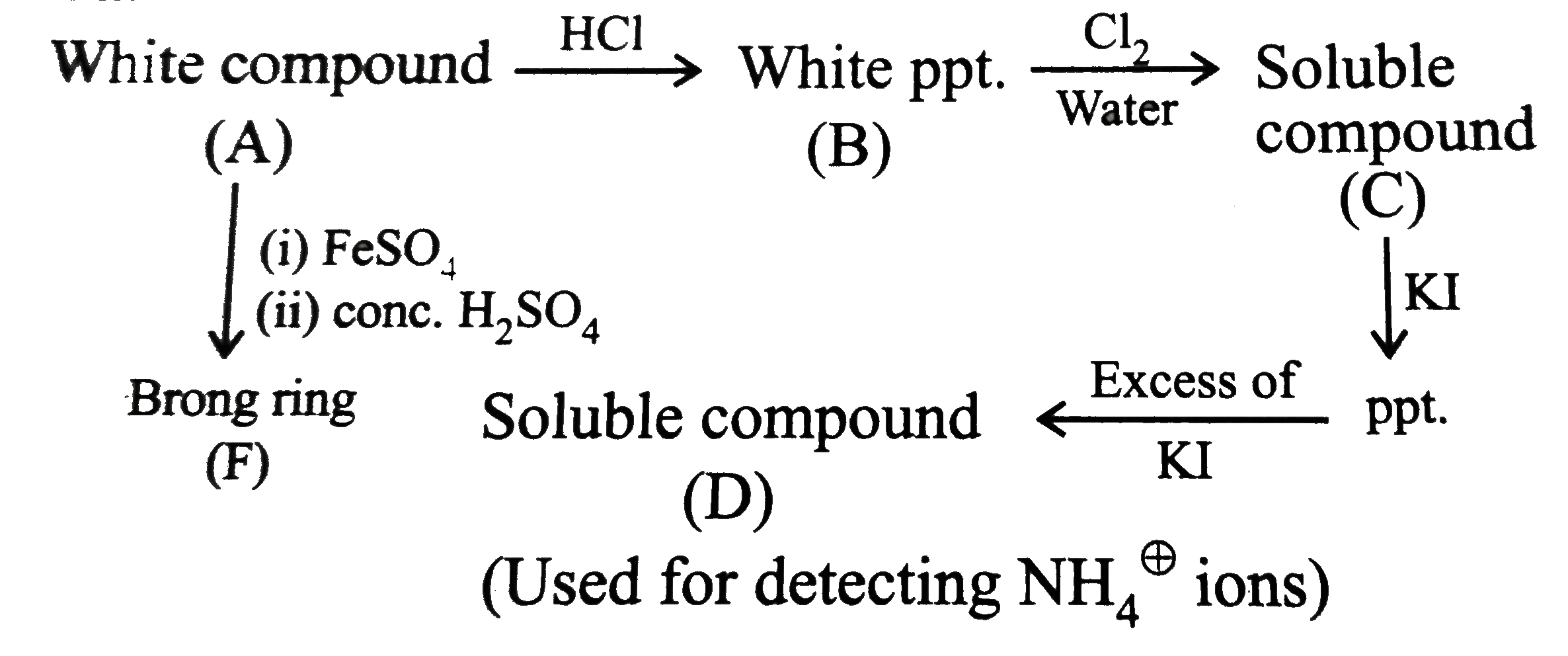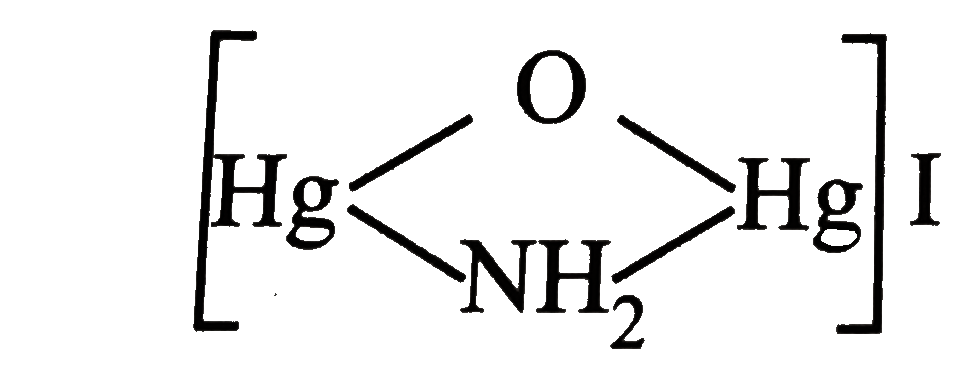
(D)in basic medium+(NH4)2SO4→ brown ppt (G)
Hence, compound(G) is
HgI2
NH4I

Hg(NH2)I
The correct Answer is:c
Topper's Solved these Questions
- QUALITATIVE INORGANIC SALT ANALYSISBOOK - CENGAGE CHEMISTRYCHAPTER - QUALITATIVE INORGANIC SALT ANALYSISEXERCISE - Exercises (Multiple Correct) Part-A (Analysis Of Anions)
31 Videos
- QUALITATIVE INORGANIC SALT ANALYSISBOOK - CENGAGE CHEMISTRYCHAPTER - QUALITATIVE INORGANIC SALT ANALYSISEXERCISE - Exercises (Multiple Correct) Part-B (Analysis Of Cations)
30 Videos
- QUALITATIVE INORGANIC SALT ANALYSISBOOK - CENGAGE CHEMISTRYCHAPTER - QUALITATIVE INORGANIC SALT ANALYSISEXERCISE - Solved Example
11 Videos
- P-BLOCK GROUP 18 ELEMENTS - THE INERT GASESBOOK - CENGAGE CHEMISTRYCHAPTER - P-BLOCK GROUP 18 ELEMENTS - THE INERT GASESEXERCISE - Ex 5.1 (Objective)
14 Videos
- REDUCTION AND OXIDATION REACTION OF ORGANIC COMPOUNDSBOOK - CENGAGE CHEMISTRYCHAPTER - REDUCTION AND OXIDATION REACTION OF ORGANIC COMPOUNDSEXERCISE - SUBJECTIVE TYPE
3 Videos
Similar Questions
The nitrogen compound formed when (NH4)2SO4 is heated is
View SolutionFour isomeric optically active compounds NaHCO3−−−−−→CO2(g)(A,B,C,D)(C4H8O3)
Compound (A)LAH−−→(E) (Archiral compound)
Compound (B)KMnO4−−−−−→orCrO3 Inert to oxidation.
Compound (C)−−−−−−−−→NaOI/H3O⊕CHI3(Yellowppt.)+Compound(F).
Compound (D) is :
View Solution
Knowledge Check
Al2(SO4)3+NH4OH→X, then:
AX is a white coloured compoundBX in insoluble in excess of NH4OHCX is soluble in NaOHDX cannot be used as an antacid(White ppt)DNa2CO3←−−−−−−−dil.H2SO4A↓C(White ppt)K2CrO4−−−−−−−−−→(in acetic acid)B(Yellow ppt)
If A is the metallic salt, then the white ppt. of D must be ofAStronsium carbonateBred leadCbarium carbonateDcalcium carbonateAssertion : During digestion with concentrated H2SO4, Nitrogen of the organic compound is converted into (NH4)2SO4.
Reason : (NH4)2SO4On heating with akali liberatesNH3.AIf both assertion and reason are true and the reason is the correct explanation of the assertion.BIf both assertion and reason are true but reson is not the correct explanation of the assertion.CIf assertion is true but reason is false.DIf the assertion and reason both are false.
Four isomeric optically active compounds NaHCO3−−−−−→CO2(g)(A,B,C,D)(C4H8O3)
Compound (A)LAH−−→(E) (Archiral compound)
Compound (B)KMnO4−−−−−→orCrO3 Inert to oxidation.
Compound (C)−−−−−−−−→NaOI/H3O⊕CHI3(Yellowppt.)+Compound(F).
Compound (C) is :
View SolutionFour isomeric optically active compounds NaHCO3−−−−−→CO2(g)(A,B,C,D)(C4H8O3)
Compound (A)LAH−−→(E) (Archiral compound)
Compound (B)KMnO4−−−−−→orCrO3 Inert to oxidation.
Compound (C)−−−−−−−−→NaOI/H3O⊕CHI3(Yellowppt.)+Compound(F).
Compound (D) is :
View SolutionFour isomeric optically active compounds NaHCO3−−−−−→CO2(g)(A,B,C,D)(C4H8O3)
Compound (A)LAH−−→(E) (Archiral compound)
Compound (B)KMnO4−−−−−→orCrO3 Inert to oxidation.
Compound (C)−−−−−−−−→NaOI/H3O⊕CHI3(Yellowppt.)+Compound(F).
Compound (A) is :
View SolutionFour isomeric optically active compounds NaHCO3−−−−−→CO2(g)(A,B,C,D)(C4H8O3)
Compound (A)LAH−−→(E) (Archiral compound)
Compound (B)KMnO4−−−−−→orCrO3 Inert to oxidation.
Compound (C)−−−−−−−−→NaOI/H3O⊕CHI3(Yellowppt.)+Compound(F).
Compound (B) is :
View SolutionFour isomeric optically active compounds NaHCO3−−−−−→CO2(g)(A,B,C,D)(C4H8O3)
Compound (A)LAH−−→(E) (Archiral compound)
Compound (B)KMnO4−−−−−→orCrO3 Inert to oxidation.
Compound (C)−−−−−−−−→NaOI/H3O⊕CHI3(Yellowppt.)+Compound(F).
Compound (F) is :
View Solution
